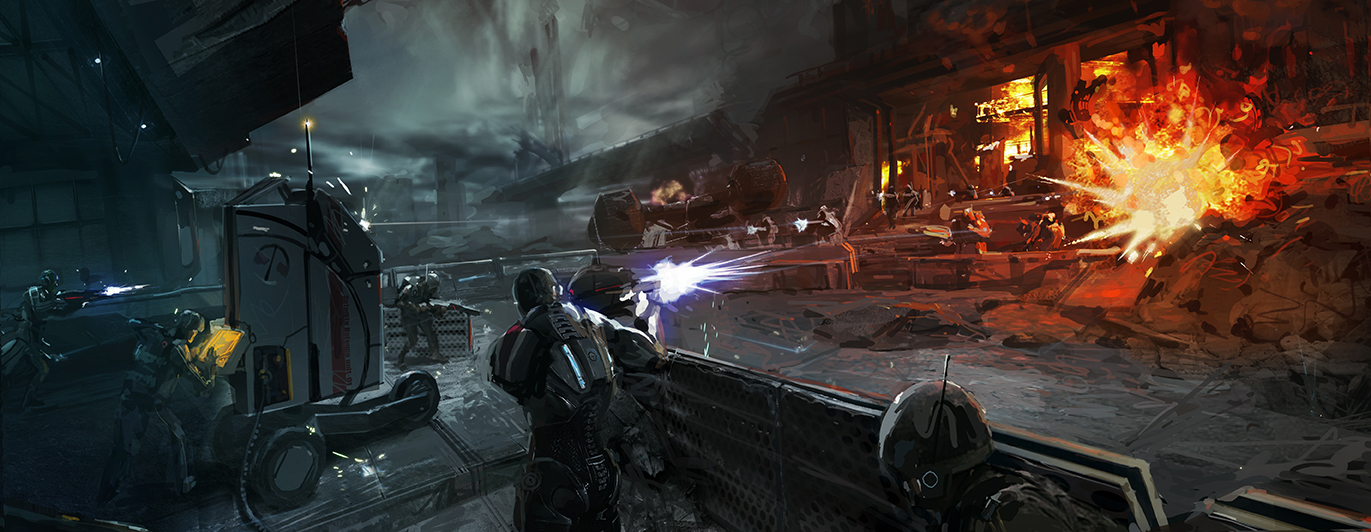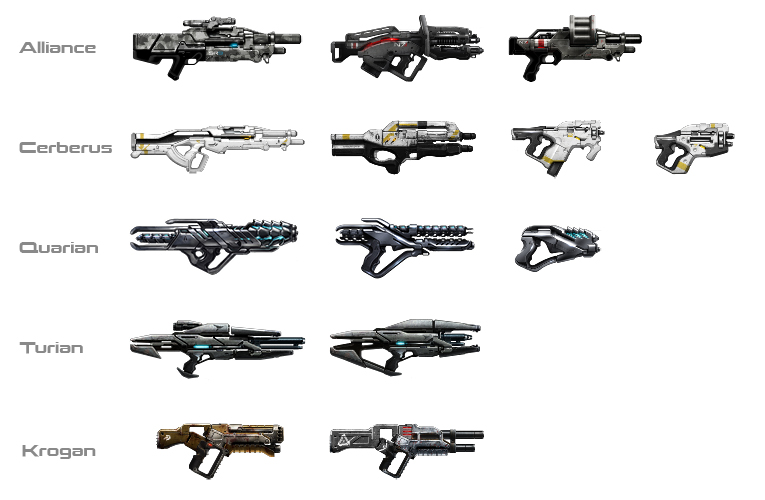
In the question of how best to destroy your enemies, there are no wrong answers.
Mass Effect 3 Lead Combat Designer Corey Gaspur has a virtual armory list full of wild and impractical weapon ideas. Some describe how the weapon should work, such as the one-shot, high-powered, extremely accurate rifle that would eventually become the Mattock. And some—like the shotgun pitchfork—are delightfully blunt.
“Literally anything goes (during brainstorming),” Gaspur says. “The shotgun pitchfork sounds silly, but it could work. If you throw on an Omni-tool with a three-pronged bayonet, I could totally see it working.”
The combat team then refines the mountain of gunchucks, spike grenades, and lightning swords, picking out their favorites and discussing how they can and should function. As the Mass Effect trilogy evolved and more lore was established, they began to design weapons based around each faction’s composition was and how it fought.
The brutal krogan enjoy getting up close and personal in fights to take advantage of their hardened bodies and ferocious strength. As a result, their weapons were envisioned as power tools, Gaspur says: heavy, blunt, and efficient. “We wanted them to feel like chainsaws or jackhammers,” he says.
“For Cerberus, our central idea was high-tech, clean, and streamlined. The important thing is making sure each faction has a coherent theme.”

From there, the art and visual effects teams step in to breathe life into tools of death. They shape the look and feel of a weapon based on its intended used and who’ll be carrying it. These core ideas affect everything from barrel color to how the camera reacts when a gun is fired, Gaspur says. As a result, the weapons feel more grounded in reality, creating a more immersive experience. It’s easier to believe that science-oriented salarians would fire sleek, high-tech weaponry with precise sounds than smoke-belching, cast-iron cannons from a floating pirate fortress.
For a character-specific weapon like Varric’s Bianca, the effect of backstory on design is even more extreme. Bianca is a purely mechanical repeating crossbow capable of firing three bolts at once, says Matt Goldman, Art Director for Dragon Age II and Dragon Age: Inquisition. A shotgun aficionado, Goldman decided Varric’s one true love would work best as a pump-action, break-breach loader, multi-shot bolt and grenade thrower.
To convince himself that such a weapon was even possible, Goldman spent hours working mechanisms for trigger, safety, and spring-loaded bayonets. He even figured out different forms of flechette and sabot ammunition that could make the “rhyming triplet” possible. As a result, Bianca isn’t just the only working weapon of her kind in Thedas, she’s an example of something that could actually exist there.
“Normally weapons must conform to established game specifications to meet performance requirements, so you’re limited by things like scale, the number of parts, grip location, and the number of polygons,” Goldman says. “For Bianca, we ignored all that because she’s special. This caused an incredible amount of work for the animation tree, because they had to make and maintain a special animation tree just for Varric. Sorry about that, guys.”
Even when the design is done, the work’s still not finished, Gaspur says. You can only start seeing whether your idea works when the weapon is dropped into the game. For the Krysae sniper rifle, the original idea was to have a scope that auto-zoomed on targets for easier aiming; good in theory, but less so in practice.
“It ended up making people motion sick,” Gaspur says. “If you were aiming at six guys, it was going in and out and in and out, and it made people nauseous.”
Balance is also a constant struggle, especially after a game is released, he says. No matter how you originally intended a weapon to work, players always find new ways to exploit them, and a little ingenuity can transform a back-up pistol into a game changer.
In the earlier days of ME3’s multiplayer, the combat team noticed that the Acolyte was being used in 90% of matches. Players had learned how to increase the rate of fire and were using the sidearm to decimate wave after wave.
“You could go watch videos of people just smashing enemies,” Gaspur says. “It was ridiculous.”
In such cases, the team examines how the weapon is being used, and by whom, then decides whether or not the way the gun works is healthy for the game. Certain weapons can frustrate the combat designers when a skilled players get their hands on them, says Gaspur, but the key is making sure that the weapon itself isn’t game-breaking.
“It’s tough, because you want people to feel overpowered while they are using it, and you want them to feel bad ass and like they’re destroying things, but you want that to happen when the weapon is actually working as intended,” he says. “The big challenge is making sure people are still having fun, because you don’t want to swing the pendulum too far the other way and nerf it.”